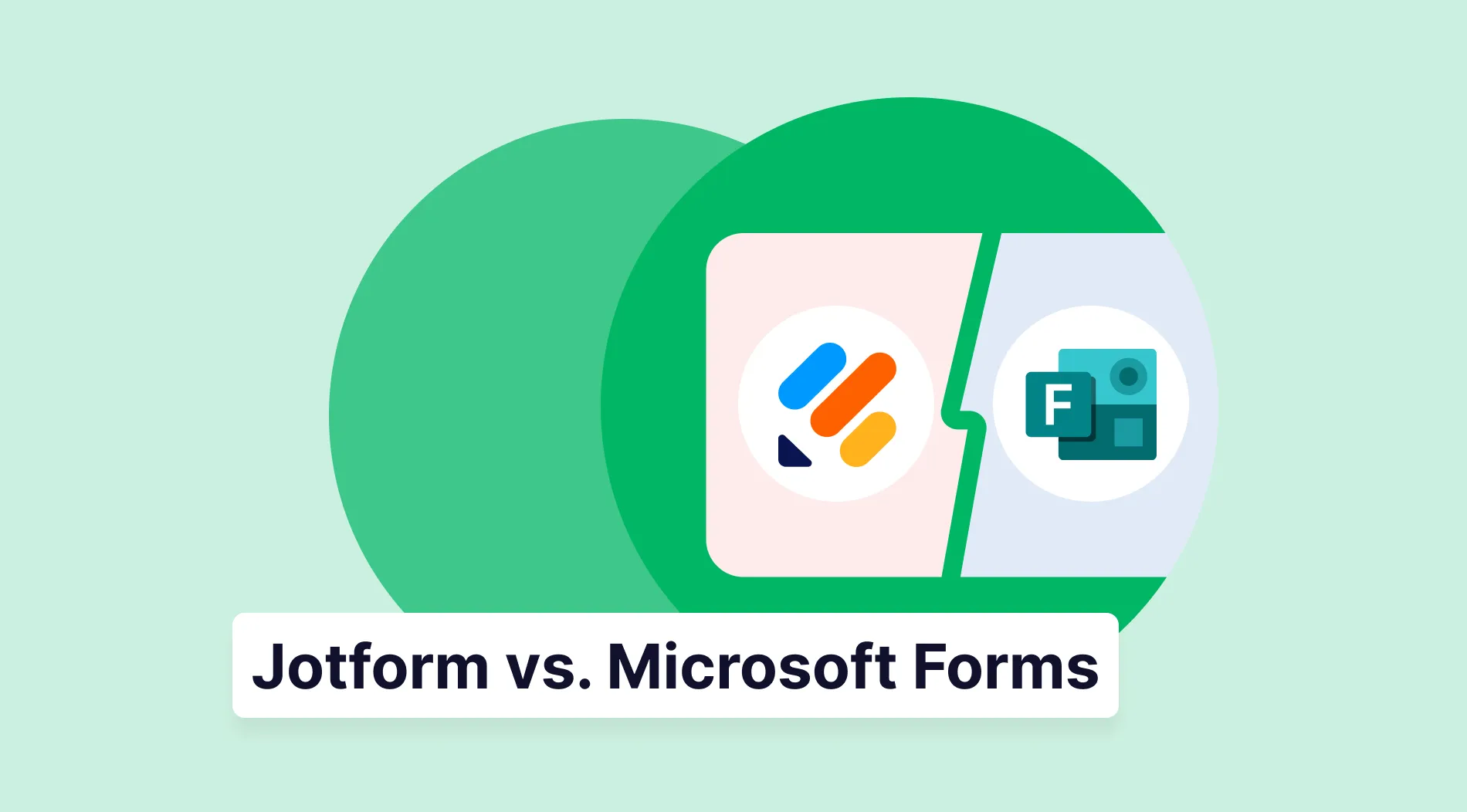Businesses and companies want to create high-quality products for their target market, target audience, and their expectations. This standard should also align with the value they set for the product. To achieve that, they famously receive customer feedback and reviews.
Concept testing surveys are one of the most effective ways to ensure that the new product is up to certain standards. This article is a guide to concept testing, which will give you practical insights into concept testing survey examples and methods with their pros and cons, from what they are to how they are used, with practical details.
First things first: What is concept testing in marketing?
A concept testing survey is an early market research method that is provided to the focus groups in the early stages of a product to get feedback and reviews.
It allows businesses to make any changes or improvements necessary before product launches.
Concept testing includes specific questions related to a new product or service to check the quality and standards and make sure they meet the needs and expectations of the potential customers.
Why do you need a concept testing survey?
As mentioned previously, concept testing surveys are efficient tools for understanding that a potential product has all the essential features that are estimated by businesses. Through this method, businesses can have a good idea of how the market will react when the product is finally on the market.
However, mistakes and modifications can be costly. That is why it is vital to gain a proper understanding of how your product fits into the market by leveraging research and insights from your potential customers to ensure you make the best decision for a successful product.
Here are 5 reasons why a concept testing survey is essential:

Benefits of concept surveys
1. Budget-friendly and versatile
You can easily create a simple survey to have straightforward feedback from your targeted audience. You can also set up your survey with more specific and detailed questions to receive a more insightful evaluation.
2. Useful tool for fine-tuning your product or service
The insights you collect from the surveys provide concrete indications to make the best possible decision for your product. Throughout the process, you can discover and pinpoint information that significantly influences your decisions in the product development process.
For instance, you can assess the effectiveness of the concept’s brand equity, brand image, benefits, and other specific features according to the customers’ feedback. Additionally, it can help you understand the perception of the price range, buying preferences, and potential use.
3. Ongoing quality-assurance check
You can send your concept testing questions to your target audience to reflect on your improvements, as well as engage a new target market to gather fresh perspectives on your design and developments. This will help you diversify your audience to gain different insights.
Besides, concept testing surveys play a pivotal role in establishing future benchmarks. Concepts that meet key criteria and resonate effectively with your audience can be used as standards for evaluating new or similar concepts.
4. Key to fostering strong customer relationships
Involving potential customers in the design and development of the product can help establish brand and customer loyalty. This also helps boost your brand equity value. In this way, you can present your brand as transparent and open to new ideas and changes and also demonstrate a sincere appreciation for the opinions of your customers.
5. Competitive advantage
By testing your concept against competitors or alternative ideas, you can gain a competitive advantage. Understanding how your concept compares to others in the market helps you position your product or service effectively.
When to use a concept testing survey?
Concept testing surveys can be done at any stage of the production period, whether it is about brand testing, logo testing, or other features of the product. They can be used during the idea screening, prototyping, or right before launching the product.
⏰ Idea screening: After brainstorming and evaluating ideas, narrow down the solution to advance in the product discovery stage and identify the most effective approach to address potential user issues.
⏰ Prototyping: Evaluate the details of various design, logo, or functionality ideas, starting from basic representations.
⏰ Before the product launch: Ensure you address any final adjustments that may be necessary to help you determine which marketing ideas are suitable for your upcoming campaign.
Methods of concept testing
It is important to note that every product requires different types of methodology that will best fit the needs. You can choose the type of method that suits you the best to create your survey and get the most effective results.
Particularly, there are 4 common survey methodologies, including Monadic (Single Concept Evaluation) Testing, Sequential (Multiple Concept Evaluation), Monadic Testing, Comparative Testing, and Protomonadic Testing. Depending on sample sizes, each method comes with its pros and cons, which could help you make the best decision by choosing the most suitable option for your product.
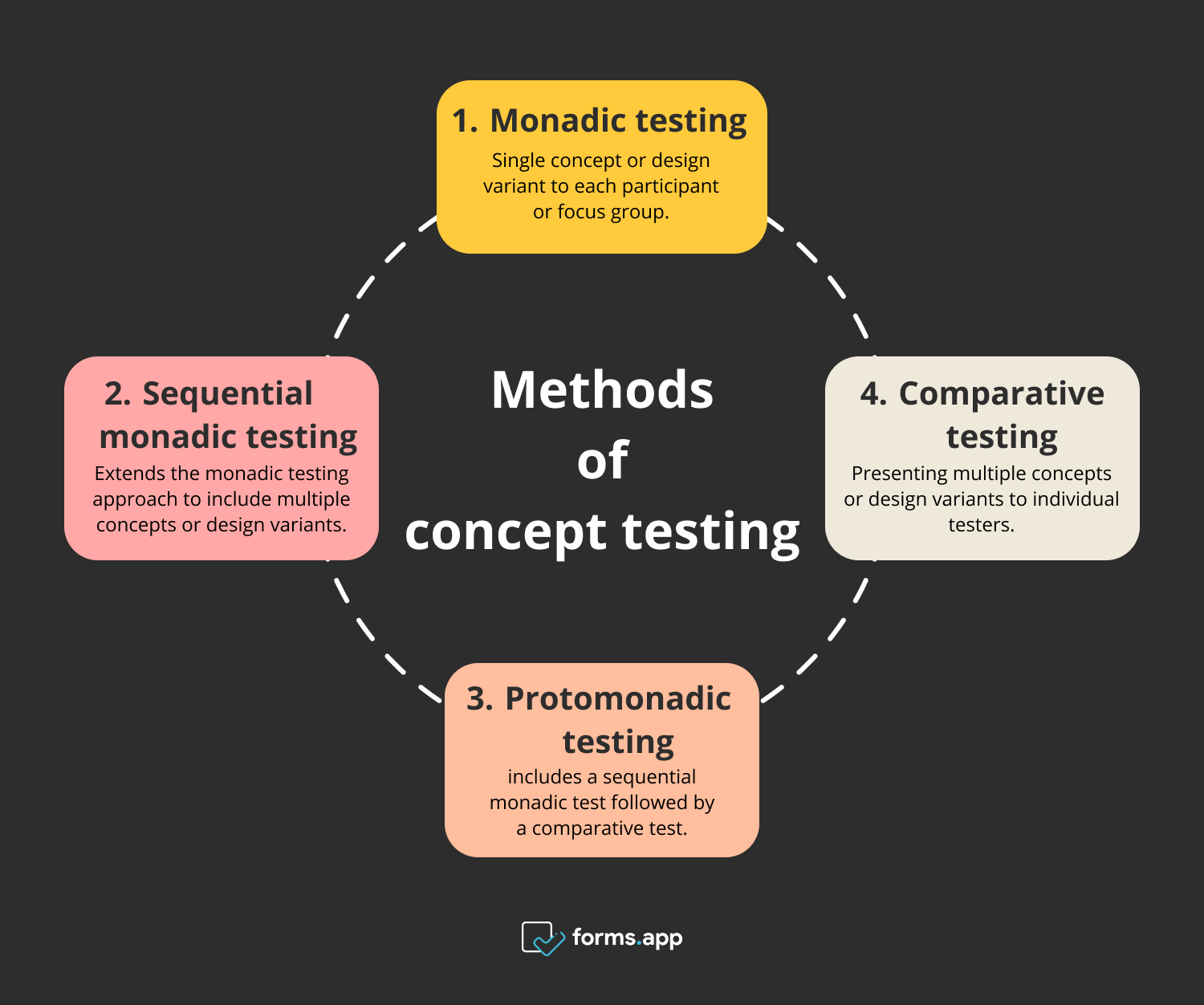
Concept testing methods
1. Monadic testing
As the name of this method of testing suggests, it presents a single concept or design variant to each participant or focus group. By this method, each participant experiences or evaluates only one concept, allowing for a focused analysis of that specific idea. This method is useful for obtaining in-depth insights into individual concepts.
Pros:
➕ Flexible and fast for the respondent
➕Provides an unbiased view of each concept
➕Gives a better response rate
➕Shows detailed results for every concept
Cons:
➖Requires more responses
➖More expensive
➖Takes longer
2. Sequential monadic testing
This method extends the monadic testing approach to include multiple concepts or design variants. Participants or focus groups evaluate different concepts separately, which allows researchers to gather feedback on each concept independently. This method is useful for comparing the performance of various concepts.
Pros:
➕Gives detailed results for every concept
➕Requires fewer responses
➕More cost-effective
➕More efficient for the researcher
Cons:
➖The response time takes longer
➖Poorer response rates
➖Introduces bias to other concepts
3. Comparative testing
This method involves presenting multiple concepts or design variants to individual testers. Participants compare and evaluate these concepts by using rating questions or asking to choose the best one among them.
Pros:
➕Gives clear and easily understandable results
➕Efficiently provides feedback on multiple ideas in a single session
➕Provides valuable insights into the strengths and weaknesses of each concept
Cons:
➖Difficult to tell why one concept is selected over others
➖Demonstrates limited individual feedback
4. Protomonadic testing
This method includes a sequential monadic test followed by a comparative test. Through this method, participants first evaluate multiple concepts and then choose the concept they prefer. It is useful for validating results from the sequential monadic test.
Pros:
➕Provides comprehensive insights
➕Versatile and allows participants to evaluate different concepts
➕Provides balanced feedback
Cons:
➖Demands more time
➖Complexity may affect the accuracy and reliability of participants’ feedback
➖This might present challenges when interpreting results from both stages
7 example concept testing example questions
Concept testing questions can vary according to the type of product or service. Writing good survey questions can provide you with a clear understanding of the needs and expectations of the market and increase the chance of perfecting your product for its initial launch.
In this section, you can find some helpful sample questions of product concept tests and how and why you can use them in your survey.
1. How likely are you to buy or use this concept if it were available?
This question lets you know if the customers would use the concept or not. Responses will help you evaluate the perceived value of the concept and inform decisions on whether it aligns with consumer preferences.
💡You can provide a rating scale with labels such as 'Very likely,' 'Likely,' 'Neutral,' 'Unlikely,' and 'Very unlikely.'
2. Which features of this concept do you find most appealing?
If you ask this question, you can learn which features of the concept customers find most appealing. By understanding which features resonate most with the target audience, businesses can prioritize and refine these elements to maximize their appeal and desirability.
💡You can use 'free-listing questions' by asking your respondents to list the features they find most appealing without any restrictions.
3. On a scale of 1 to 10, how likely are you to recommend this product to a friend?
This question can be used to measure customer satisfaction and understand the likelihood of recommendations. This could be helpful for business owners to investigate and understand what they might need to change or fix in their product in order to meet the customers’ expectations.
💡You can present this question in a 'Likert Scale' format, providing 10 options, and let the participants choose the numbers from 1 to 10.
4. What factors might prevent you from using this product?
This open-ended question example helps uncover any obstacles that might disrupt adoption. It also enables organizations to address these factors and increase the chances of successful market entry.
💡You can ask the respondents to share any concerns they might encounter when using the product.
5. Would you be willing to pay more or less for this concept?
This question can provide valuable information for pricing strategies, ensuring that it aligns with the customers’ expectations and is also competitively priced in the market. After collecting responses to the question, you can determine an appropriate pricing strategy for the concept.
💡You can present some price points and ask the participants to indicate their preference by using 'Likert scales' or 'multiple choice answers.'
6. Is there anything you think is lacking or could be added?
This question can provide qualitative insights into potential improvements needed for the product or service. To improve your concept, you need to give participants the opportunity to express their opinions freely. Only in this way you can collect insightful data.
💡You can use this question as an 'open-ended question' to receive respondents’ opinions on the concept.
7. What is your overall impression of this concept?
You can receive participants’ holistic perceptions of the concept through this question. It provides a comprehensive assessment of the concept. Also, since the question asks for the overall impression, it is better to keep it at the end of your survey questions.
💡You can use it as a 'close-ended question' by adding a 'rating scale', or let your participants express their opinions more freely by using statements.
How can I create a concept testing survey?
To create a concept testing survey, you will need a good and reliable online form builder. You can find all the features you need to make your personalized survey on forms.app. Here are the steps to help you create your survey:
1. Sign up or log in to forms.app
In order to use the templates and create a survey, you must first create a free account or log in to forms.app with your existing account.
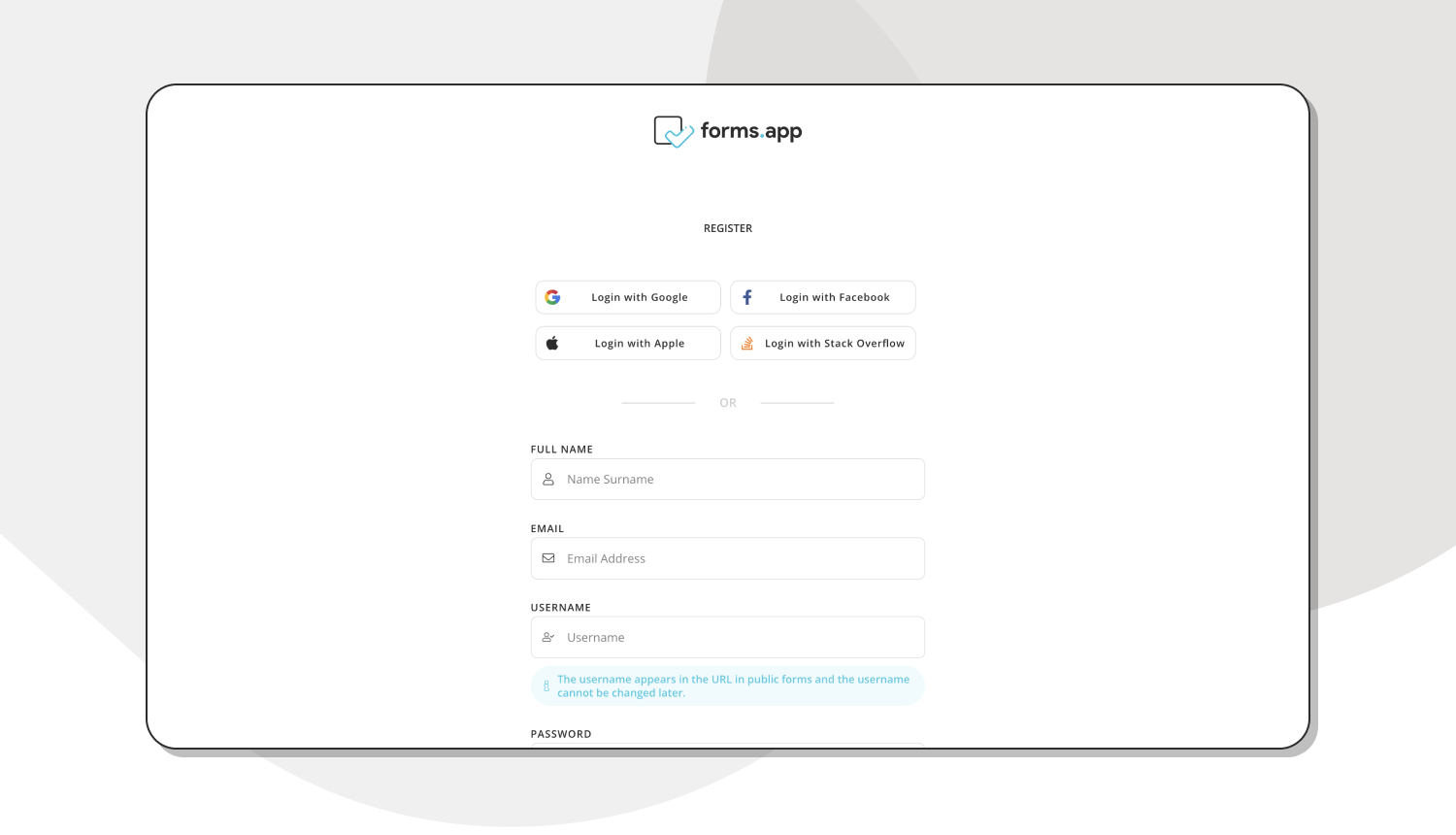
Log into your account
2. Select a template, use forms.app AI, or start with a blank form
On forms.app, you can select from a wide selection of templates. You can choose a ready-to-use concept testing survey template and edit it based on your needs. You can also use forms.app AI generator and create a survey in seconds. Also, you can start with a blank form to customize your own survey.
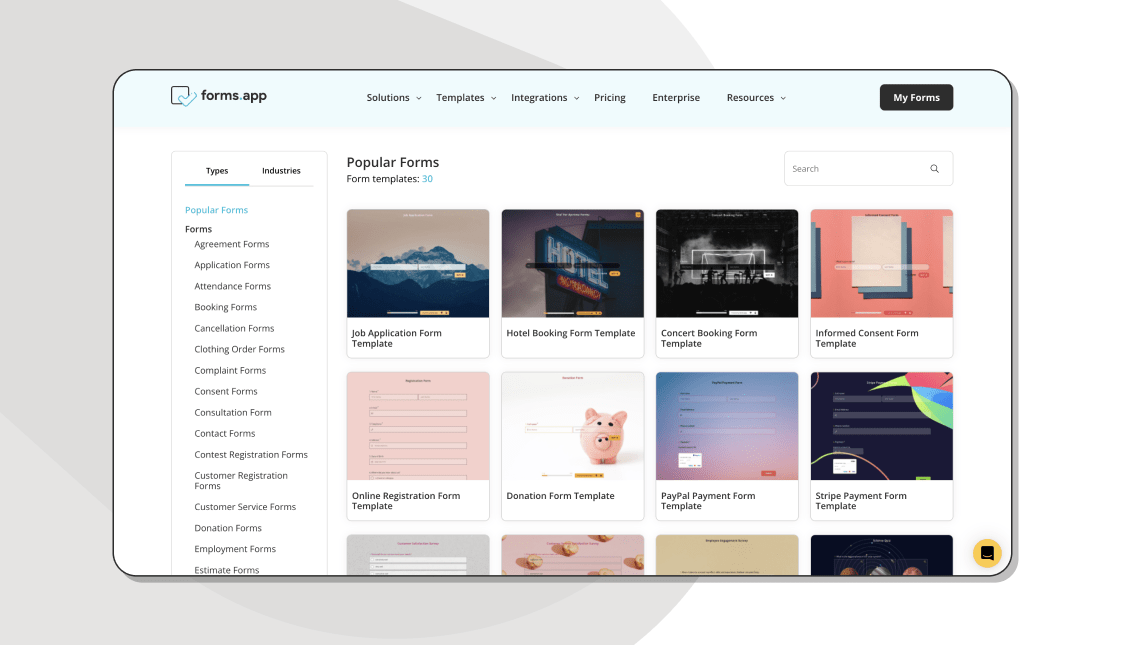
Choosing a starting option
3. Add your questions to your concept testing survey
You can add your choice of questions from the variety of options you can find on forms.app, or create your own customized questions according to the content of your survey.
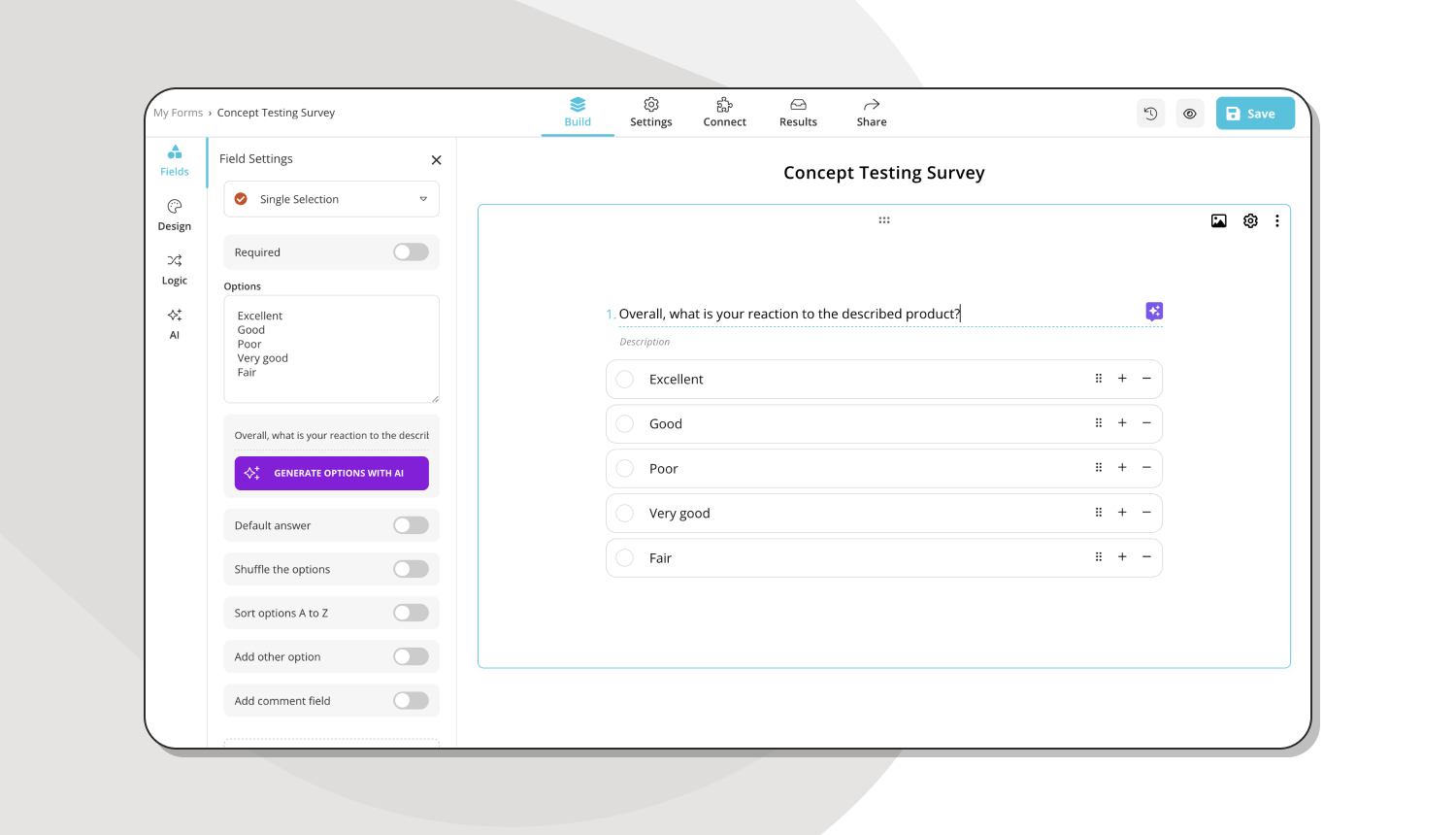
Add questions to your concept testing survey
4. Customize the look of your form
You can design your survey by using the ready-made themes to your taste on forms.app, or customize your own theme. You can change the background of your survey by choosing from the images or uploading one from your computer.
You can also choose the font and color of questions, answers, background, input, and border, and even adjust the brightness of the background image. For more options, go on forms.app.
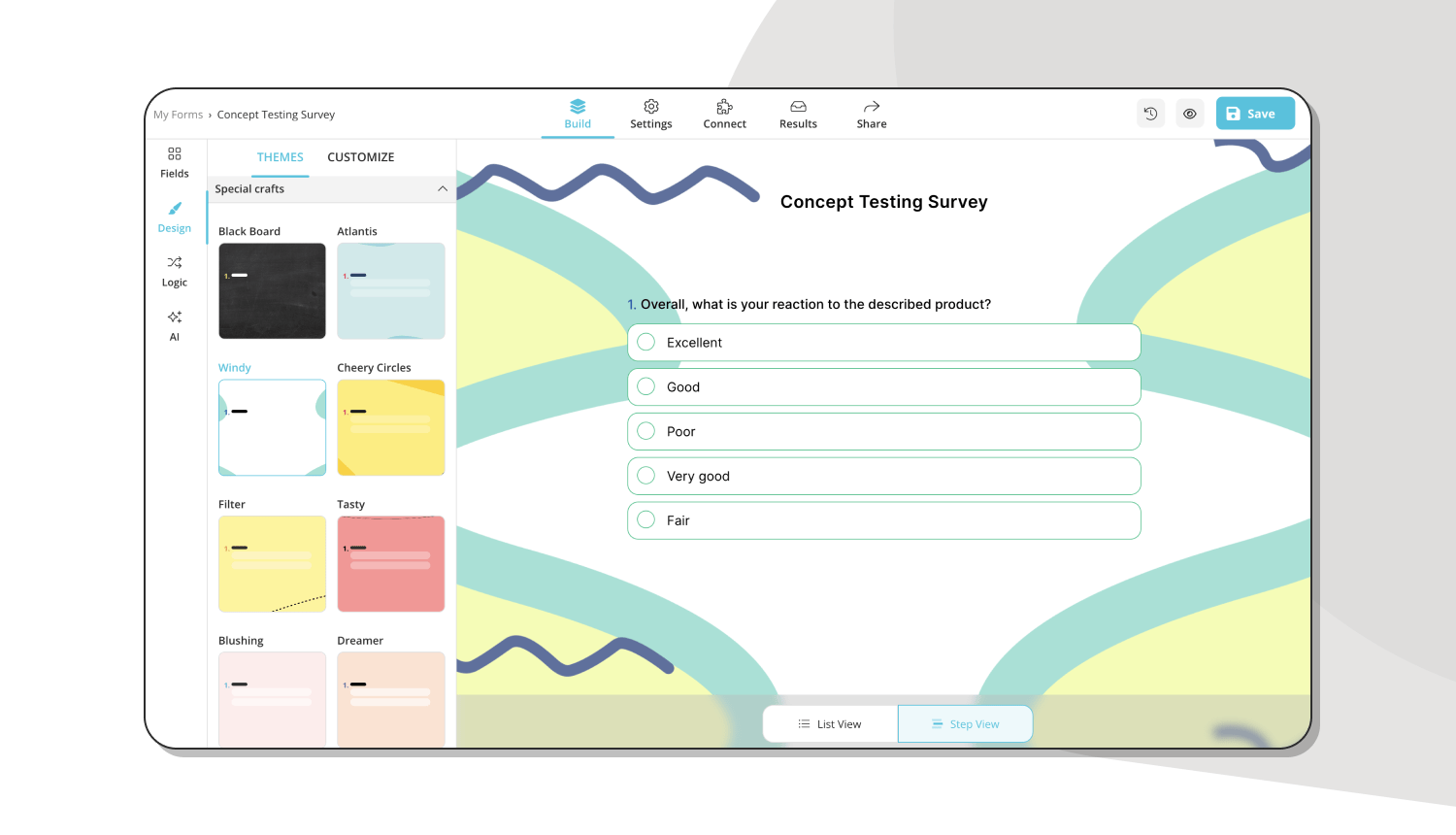
Customizing the design
5. Share your survey
You can share your survey by clicking on the 'Share' button on top. Then, you can either choose a platform you want to share your survey on or copy the link to share manually. You can also change the privacy settings of your survey link by simply clicking on the 'Setting' symbol. If you wish to customize your domain, click on the 'Customize domain' button.
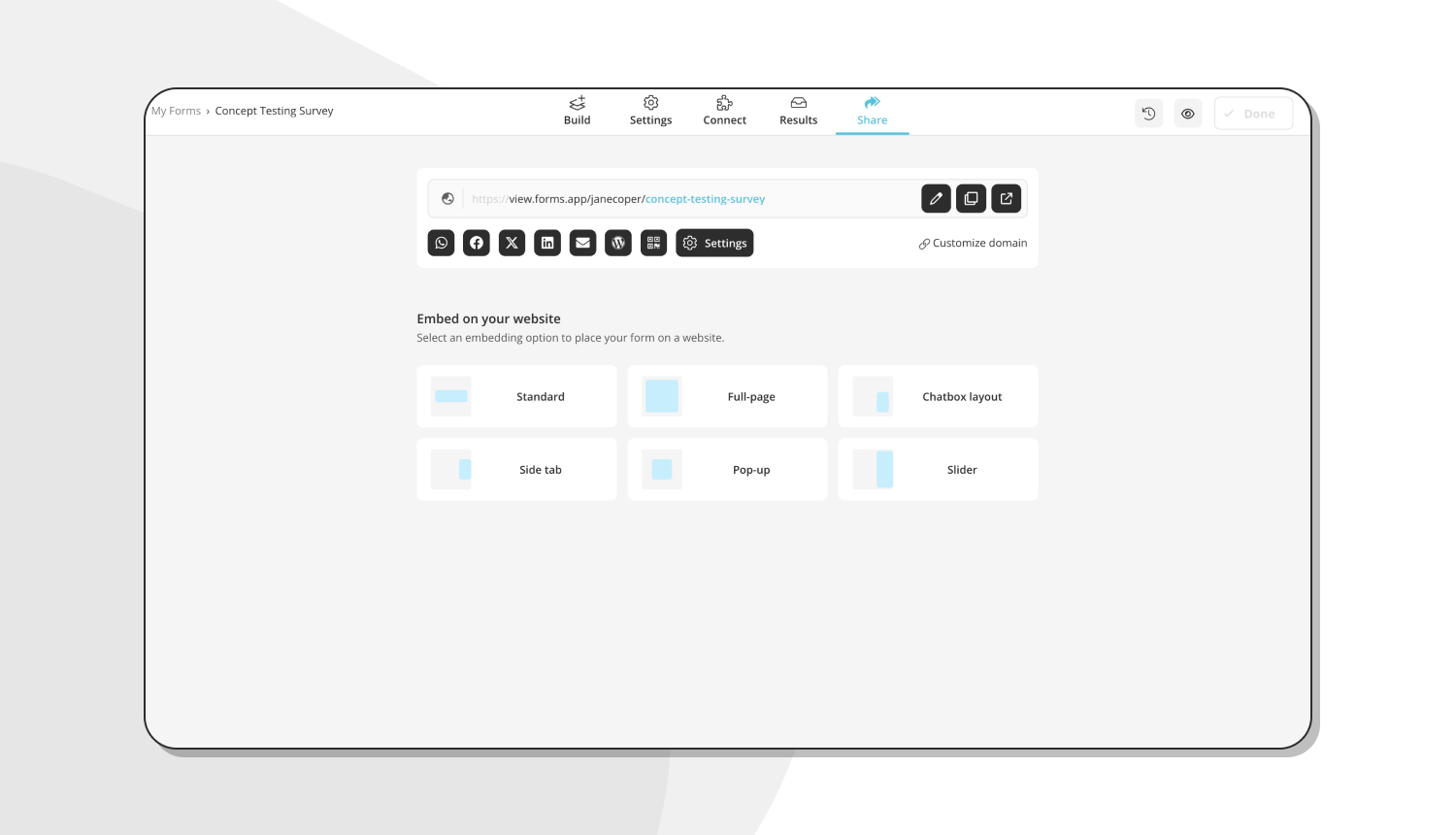
Share your onboarding survey
Frequently asked questions about concept testing survey
Up to here, you have learned many things about concept testing surveys. But you still might have questions about the issue. In addition to the insights above, here are some frequently asked questions to clarify some of the additional details about the concept testing survey that we thought might help you:
While copy testing evaluates the effectiveness of the written and verbal messaging used to communicate that concept, concept testing evaluates the overall appeal and feasibility of a new concept.
Depending on your product and objectives, you can use screening questions, concept validation questions, purchase intent questions, market research survey questions, and open-ended questions.
Concept testing is used to evaluate interest and appeal, identify strengths and weaknesses, mitigate risks, optimize features, understand market fit, and enhance decision-making.
Conclusion
All in all, concept testing surveys are essential tools that help businesses and companies revise their product ideas and eliminate potential risks before product launch. Depending on your product needs and goals, you can use different types of concept testing methods.
Concept testing surveys help you know your target audience, evaluate the market, compare the features of your product with the existing products, and receive useful customer insights. To build the best-customized survey for your product, you can use forms.app to choose from a variety of themes or create your own theme and style that best fits your product!
Elif enjoys sharing her expertise through helpful guidelines and tips about marketing and business planning. She is also a linguist who has a deep interest in maps, history, culture, and languages.
- First things first: What is concept testing in marketing?
- Why do you need a concept testing survey?
- When to use a concept testing survey?
- Methods of concept testing
- 7 example concept testing example questions
- How can I create a concept testing survey?
- Frequently asked questions about concept testing survey
- Conclusion

